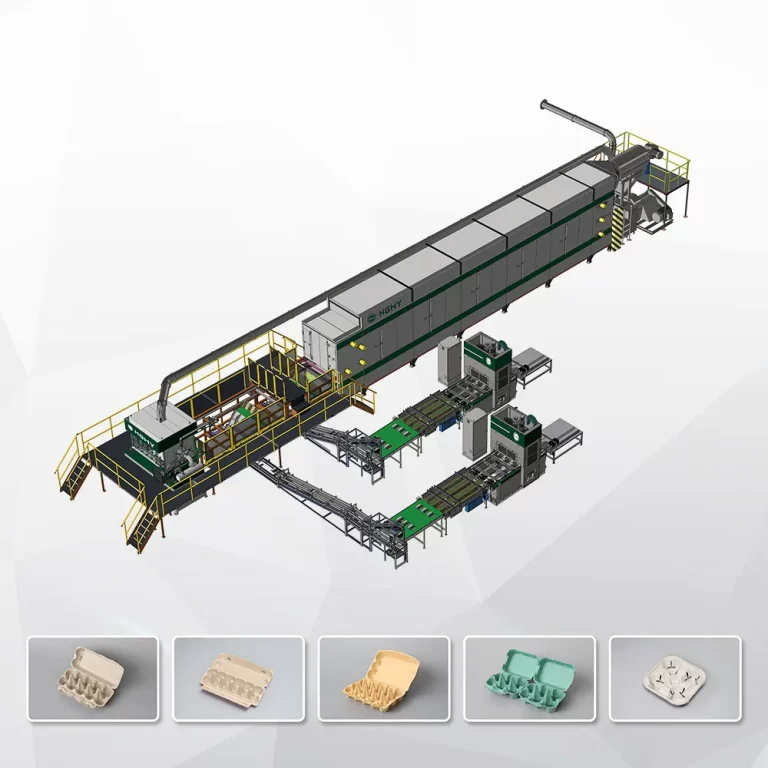Egg boxes, also known as egg cartons, play a crucial role in safeguarding fragile eggs during transport and storage. These eco-friendly containers are typically made from recycled paper pulp, contributing to sustainable packaging solutions. In this article, we’ll delve into the key aspects of crafting egg boxes, covering egg carton size, pulp molding machines, and notable manufacturers like HGHY.

Egg Carton Size: A Vital Consideration
Selecting the right egg carton size is essential for ensuring the safety and stability of your eggs. Standard sizes are designed to hold a specific number of eggs, commonly ranging from half a dozen to a dozen. Here’s a breakdown:
1. Half-Dozen (6 Eggs): These compact cartons are great for smaller households or specialty markets.
2. One-Dozen (12 Eggs): The most common size, suitable for everyday use in households and retail.
3. 18 Eggs and Beyond: Larger cartons cater to households with higher consumption rates or commercial purposes.
4. Custom Sizes: Tailored options are available for unique requirements.
When determining carton size, it’s important to consider both consumer preference and market demand.
Pulp Molding Machines: The Heart of Egg Box Production
Pulp molding machines are indispensable in the production of egg boxes. These machines utilize recycled paper pulp as their primary raw material. Here’s an overview of the process:
1. Pulping: Waste paper, cardboard, or agricultural residue is pulped into a slurry.
2. Molding: The slurry is then poured into molds, creating the desired shape.
3. Drying: The molded product is dried, ensuring its structural integrity.
4. Finishing: Additional processes may include trimming, labeling, and printing.
HGHY: A Leading Manufacturer of Pulp Molding Machines
HGHY is a renowned name in the field of pulp molding machinery. With a reputation for innovation and quality, HGHY offers a range of machines suitable for various applications, including egg box production. Their machines are characterized by:
– Advanced Technology: HGHY machines incorporate cutting-edge technology, ensuring efficiency and precision in production.
– Customization Options: HGHY provides tailored solutions to meet specific production requirements, from small-scale operations to large-scale industrial setups.
– Environmentally Friendly: HGHY’s machines are designed with sustainability in mind, utilizing recycled materials and minimizing waste.
HGHY EGG BOX MACHINES

HGHY Egg Box Making Machine
Egg Box Making Machine has been installed in over 150 production lines. HGHY Egg Packaging Machinery, which includes an egg box making machine and an egg carton production line, is specifically designed for the manufacturing of egg cartons, egg boxes, cup trays, punnets, and bottle trays. These products necessitate a hot pressing step after the drying process.
Egg Box Making Machine: Streamlining Production
An egg box making machine is a specialized equipment that automates the process of producing egg boxes. These machines are compatible with various molds, allowing for flexibility in carton sizes and designs. Key features of egg box making machines include:
– High Production Capacity: These machines can produce a large volume of egg boxes in a relatively short period.
– Easy Operation: User-friendly interfaces and automation streamline the production process, reducing labor costs.
– Quality Assurance: Consistent production standards are maintained, ensuring the durability and integrity of the egg boxes.
– Energy Efficiency: Modern machines are designed to optimize energy consumption, contributing to sustainable production practices.

Crafting egg boxes involves a combination of thoughtful design, advanced machinery, and sustainable practices. Understanding the nuances of egg carton size, investing in quality pulp molding machines like those offered by HGHY, and utilizing efficient egg box making machines are all crucial steps toward producing high-quality, eco-friendly packaging solutions. By following these guidelines, you can contribute to both the protection of fragile goods and the promotion of sustainable packaging practices.




